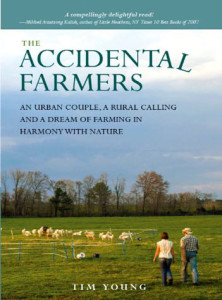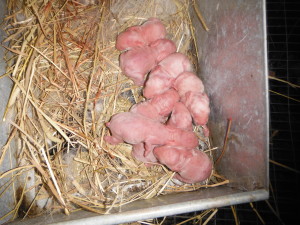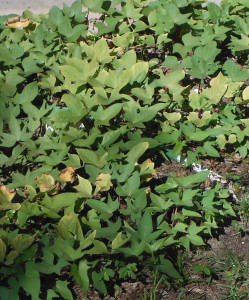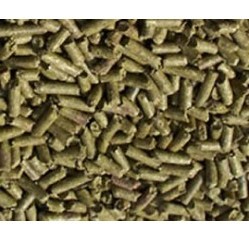I was fortunate to run into Aaron of the InTheRabbitHole Podcast Monday night in a group meeting, and of course the subject of rabbits was talked about for quite a long time. One of the subjects we discussed was what to do in the event that the regular feed, in my case this meant rabbit pellets, was unavailable. I feel that in this time of economic uncertainty, this is a more probable than possible, if only for a short time.
The reason could stem from a variety of things, job loss resulting in no money for rabbit feed, a severe drought causing grain shortages, a hurricane preventing local deliveries, civil unrest, or simple a zombie horde, all possibilities, though I’ll admit some are very unlikely.
The easiest way to meet a domestic rabbit’s diet is by feeding pellets. I lean towards a particular brand of pellets that shall remain unnamed. Here is their nutritional ingredient list:
dehydrated alfalfa meal, wheat middlings, soybean hulls, soybean meal, feeding oatmeal, cane molasses, brewers dried yeast, saccharomyces cerevisiae fermentation solubles, dl-methionine, calcium carbonate, monocalcium phosphate, dicalcium phosphate, salt, ferrous carbonate, ferrous sulfate, copper sulfate, manganous oxide, manganese sulfate, zinc oxide, zinc sulfate, cobalt carbonate, calcium iodate, sodium selenite, vitamin a supplement, vitamin d3 supplement, vitamin e supplement, thiamine mononitrate, riboflavin supplement, niacin supplement, choline chloride, calcium pantothenate, pyridoxine hydrochloride, folic acid, biotin, vitamin b12 supplement, yucca schidigera.
While it may provide a balanced diet, I’m unsure what many of the items are. However, I’m positive a wild rabbit would never find them in the form they are offered in the pellet. This product is said to be fed as “the sole ration to the milking doe and her litter on a free choice basis, and is a complete diet. Hay and other forages can be fed, but are not required. Provide fresh, clean water at all times.”
One-stop feed, just add water! It really is that simple, and while the ingredient list may seem obscure, it provides the optimum diet to produce market weight rabbits in the least amount of time. That’s the good news.
The bad news is that a 50 pound bag is now almost $18+, not counting the 45 minute drive to get it. Several years ago when I first got into raising meat rabbits, the same product was $13. The costs of raising rabbits keep going up.
I try to buy my feed when I’m in the area already for other reasons, to try to offset the expense a bit, but with three breeding does, a mature buck, and anywhere from 3 to 30 young rabbits growing out, most months I have to purchase several bags, as well as buying hay for them as a filler between meals.
The Idea
With this in mind, I decided to look into alternative options for feeding my rabbits. Grass, hay, twigs, vines, bulk grains and weeds were all viable options I found each with its own level of success. Unfortunately, without some serious time inputs, its almost impossible to achieve the level of nutritional efficiency that pellets offer. This means my grow out time go from 7-8 weeks to as many as 12-14 weeks before achieving a harvestable weight. But since I’m not in a production environment with deadlines, I decided that longer production times would be an acceptable tradeoff.
The first hurdle I ran into was that if you varied a rabbit’s diet, you can cause health issues, including death. But after reading Tim Young’s Accidental Farmers, I decided I would bred for MY requirements, not be restricted by some other rabbitry’s doctrine. Accidental Farmers talks of starting into farming with the goal of no drug or medical crutches to allow genetic weakness to be passed on to future generations, eliminating the need for the crutch.
For example, in trying to establish fee-ranging pigs, the Youngs lost almost every piglet born due to poor mothering traits of the pigs they initially chose to raise. By selecting pigs with better maternal instincts, they eventually ended up having pigs that were able to maintain their numbers without the assistance of vets, special brooding pens, or and drugs.
This was a model I chose to copy with my rabbits. If I could get my rabbits used to eating whatever I put in front of them, in tight or tough times, I’d be able to continue to produce rabbits. I realized that I would have problems, and would lose some rabbits along the way, but by doing what was hard now, I was making my future an easier one.
The Process
Since I already fed hay to the rabbits, I started to add in a bit of green grass when topping of the hay. About once a week, I would add in some greens, and seeing no change in health, I gradually increased the amount of green I would provide. I also started including grape vines with leaves still attached for them to munch on. These would be consumed almost as fast as the grass. Every week or two, I would add another weed, tree limb or other green growth to the mix from a list of allowable options (see below) and watch for any adverse affects.
Results
I kept my eye out for a young animal that seemed to flourish on the modified diet, and eventually came up with one that did, and she became my third breeding doe, replacing one that had an aggression problem. Every culling I do is based on a set of breeding rabbits that work well for me. Selective breeding has resulted in my rabbits being able to deal well with a varied diet, the summer heat, and still be able to produce a harvestable rabbit with a good meat-to-bone ration, all in a reasonable amount of time.
I now have a herd of rabbits that are able to adapt to their available food source, much like wild rabbits do. Yes, I have sacrificed growth rate and possibly litter size, but I find this to be an acceptable tradeoff.
And to prove my point that it works, as I wrote this on Tuesday night, I had a doe deliver litter of 8 healthy kits. This is in addition to the 6 born two weeks ago, or the 7 in the grow out pen.
Either its that easy…or I must be doing something right.
Peace,
db
The List
Here are some of the things I feed my rabbits, mostly weeds that grow locally.
 Spanish Needles
Spanish Needles- Sunflowers ( leaves, flowers, seeds, stalks)
- Grasses of all kinds
- Grape vines and leaves
- Australian pine twigs (limited amounts)
- Sweet potato (leaves and vines)
- Basil (stems and leaves)
- Radish (stems, leaves, roots)
- Turnip (stems, leaves, roots)
- Sugarcane leaves
- Papaya Leaves
- Fruit and vegetable scraps from the kitchen
- Stale cereal
- Stale bread
- Alfalfa and or timothy hay
- Commercial pellets (yes, still, but nowhere near as mush as I used to!)
Please note this is simple what I use that grows near me. There are a LOT more options out there….
Here is a good place to start:
http://www.homesteadingtoday.com/livestock-forums/rabbits/211220-feeding-rabbits-naturally.html

I feed the wild bunnies that come into my yard, also the squirrels. I would hate to think that times will become that desperate that I would have to eat them… But the thought also entered my mind that if times got that tough, I would have a heck of a crop of meat in my backyard 🙂
You and every other predator, the two-legged kind included, will be after those critters…that is partly why I try to control my food sources by raising it myself.
Thanks for posting this! It was a great conversation to (mostly) listen to the other night. I’ve also wondered about what kinds of foods you could transition chickens and quail to, but since I’m not actually raising any, it’s mostly a speculative wondering… Garden bugs and scraps, table scraps, assumedly fruits, seeds and nuts…
Thanks, I appreciated your input as well…though I’m watching he skies a little more now.
Chickens can free-range for 100% of their food, if needed, though egg production would probably drop. Quail, however would definitely suffer, not sure if a quail tractor would get them enough nutrition to survive. Good questions….more things for me to worry about. Great.
This is really cool. I went to a Joel Salatin talk last year (yeah, here in my little country town in Australia!) and he talked about his son Daniel doing the same thing with his rabbits. He had about 50% mortality rate for the first few years, but then the desired genetic traits started to take over and things just went from strength to strength growing them out on pasture.
Joel also talked about doing similar things with other animals. One example he gave was in response to a sheep farmer who was dependent on chemical wormers. He said you’d have a few rough years while you strengthen the genetics of your herd to be more resistant to worms and parasites, but after that you won’t look back.
A lot of people have told me that I can’t feed my rabbits on anything but pellets or they’ll get sick, but I’ll be doing something similar to you and breeding them to thrive on stuff I can grow.
Keep the great posts coming!
Thanks D.
I’m trying to figure out how I could do the same with my quail, I think they offer a fantastic ROI on time, space, and money invested….
now if I could only get their food from my yard….
Okay… I looked up some stuff about quail and these looked promising:
Hunters prepping land to create quail habitat: Creating a row of uncut planted grains as a barrier between your field and the forest… Planting grains like partridge pea, kobe lespedeze, and grain sorghum. Quail also seem to favor Florida berggarweed and wild soybeans. Also corn, if you can grind it into small enough pieces. Will need to find a calcium and magnesium suppliment too… Crushed oyster shells like chicken?
Also for extra protein (and fat?) you could try raising mealworms… Would also be useful for your chickens and ducks too. Mealworms might offer enough protein for chicks too… I bet they can be dried and combined with other foodstuffs to create a more complex diet.
I think I might need to build myself a quail cage now. Forgot how tasty their eggs are!
I stumbled upon this website and really enjoyed this post. I have begun to plant mangles (a large beet for stock) for my rabbits. It is high in protein and nutrients. These mangles can reach 20 lbs. in size. Rabbits, chickens, and other livestock really love to eat them. Right now I still feed pellets as supplements. Just preparing for the future.
I’ve always considered them a more northern crop, but your post has led me to do a little more research..and I’ve found a few varieties that might grow here in Zone 10A.
Looks like I have another thing to grow now, thanks!